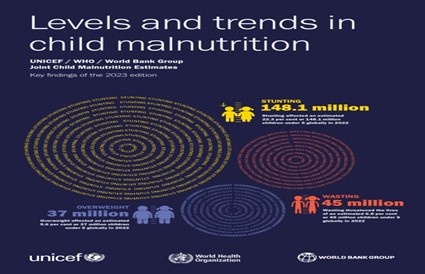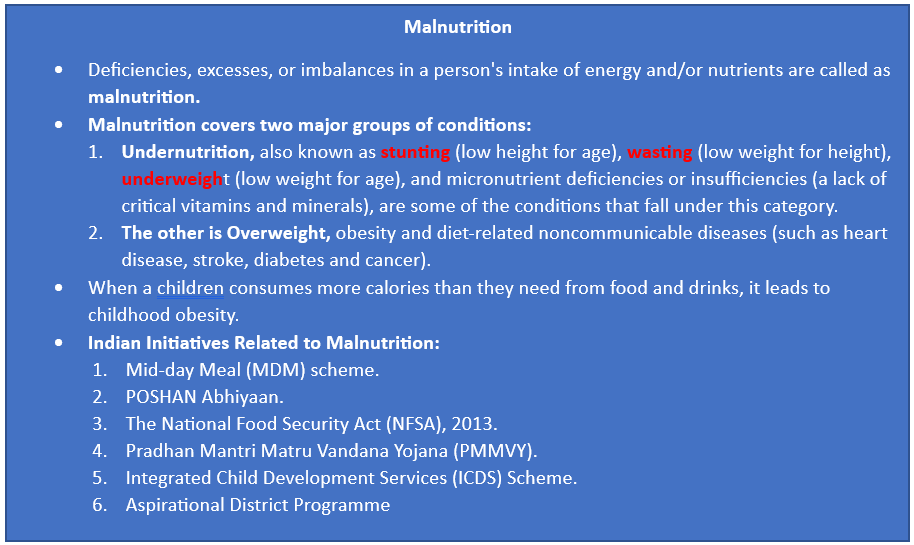- Courses
- GS Full Course 1 Year
- GS Full Course 2 Year
- GS Full Course 3 Year
- GS Full Course Till Selection
- Answer Alpha: Mains 2025 Mentorship
- MEP (Mains Enrichment Programme) Data, Facts
- Essay Target – 150+ Marks
- Online Program
- GS Recorded Course
- NCERT- First Ladder
- Polity
- Geography
- Economy
- Ancient, Medieval and Art & Culture AMAC
- Modern India, Post Independence & World History
- Environment
- Governance
- Science & Technology
- International Relations and Internal Security
- Disaster Management
- Ethics
- Current Affairs
- Indian Society and Social Issue
- CSAT
- 5 LAYERED ARJUNA Mentorship
- Public Administration Optional
- ABOUT US
- OUR TOPPERS
- TEST SERIES
- FREE STUDY MATERIAL
- VIDEOS
- CONTACT US
CHILD WASTING IN INDIA
CHILD WASTING IN INDIA
27-05-2023


Latest Context
According to a report recently published by UNICEF (United Nations Children's Fund), WHO (World Health Organisation), and World Bank Group titled "Levels and Trends in Child Malnutrition: Joint Child Malnutrition Estimates (JME)", 18.7% of Indian children will experience stunting due to inadequate nutrient intake in 2020.
Joint Malnutrition Estimates (JME)
- In order to respond to the demand for standardised child malnutrition estimates, the JME group was established in 2011.
- Annual estimates for child stunting, overweight, underweight, wasting, and severe wasting are released by the inter-agency team.
- The magnitude and patterns of under- and overnutrition are described by child malnutrition estimates for the indicators of stunting, wasting, overweight, and underweight.
- The global and regional prevalence and number estimates for each indicator are updated on a regular basis by the UNICEF-WHO-WB Joint Child Malnutrition Estimates inter-agency group.
- The 2023 Edition's main conclusions include trends for all of the variables stated, both globally and regionally, as well as modelled estimates for stunting and national at the national level.
What are the Report's Findings?
Wasting:
- India is home to half of the world's wasted children.
- Globally, wasting was expected to estimate 45 million children under the age of five (6.8%) in 2022, with 13.6 million of those children experiencing severe wasting.
- More than 75% of all children with severe wasting reside in Asia, whereas 22% do as well in Africa.
Stunting:
- India's stunting rate decreased from 41.6% in 2012 to 31.7% in 2022.
- In 2022, there were 148.1 million stunted children under the age of five in the globe.
- Africa and Asia together account for 52% of all affected children worldwide.
Overweight:
- Worldwide, there are 37 million under-five overweight children, an increase of about four million since 2000.
- India's overweight rate increased from 2.2% in 2012 to 2.8% in 2022.
Development:
- To meet the global nutrition objectives set by the World Health Assembly (WHA) and the UN-mandated Sustainable Development Goal target 2.2, insufficient progress has been made.
- WHA global Nutrition Targets are:
- Reduce stunting by 40% in children under 5.
- Reduce the prevalence of anaemia by 50% among women in the age group of 19-49 years.
- Ensure 30% reduction in low-birthweight.
- Ensure no increase in childhood overweight.
- Increase the rate of exclusive breastfeeding in the first six months up to at least 50%.
- Reduce and maintain childhood wasting to less than 5%.
- Only approximately a third of all nations are "on track" to cut the number of children affected by stunting in half by 2030, and around one-quarter of nations are unable to assess their progress to date.
- Only one in six nations is now considered to be "on track" to meet the 2030 objective of a 3% prevalence for overweight.
- For approximately half of the nations, it is not feasible to assess the progress made towards the waste objective.
Recommendations
- To survive, severely wasting children need early detection, timely treatment, and care.
- If the world wants to reach its goal of bringing the number of stunted children to 89 million by 2030, more significant efforts must be made.
- Accurately evaluating the progress made towards global objectives is difficult due to gaps in the statistics that are available in some locations. Therefore, it is essential to regularly gather data in order to track and evaluate future national, regional, and global progress on child malnutrition.



Mains
Q. How far do you agree with the view that the focus on lack of availability of food as the main cause of hunger takes the attention away from ineffective human development policies in India? (250 words)



